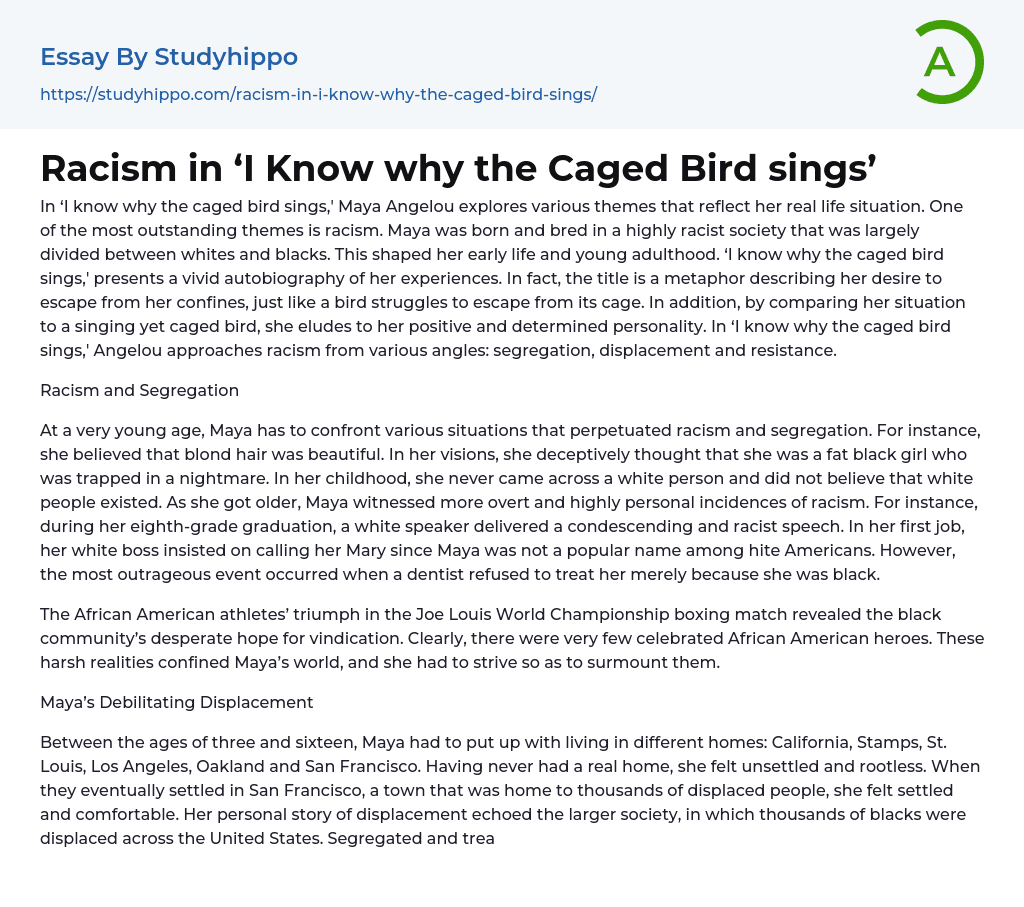

Racism in ‘I Know why the Caged Bird sings’ Essay Example
In ‘I know why the caged bird sings,' Maya Angelou explores various themes that reflect her real life situation. One of the most outstanding themes is racism. Maya was born and bred in a highly racist society that was largely divided between whites and blacks. This shaped her early life and young adulthood. ‘I know why the caged bird sings,' presents a vivid autobiography of her experiences. In fact, the title is a metaphor describing her desire to escape from her confines, just like a bird struggles to escape from its cage. In addition, by comparing her situation to a singing yet caged bird, she eludes to her positive and determined personality. In ‘I know why the caged bird sings,' Angelou approaches racism from various angles: segregation, displacement and resistance.
Racism and Segregation
At a very young age, M
...aya has to confront various situations that perpetuated racism and segregation. For instance, she believed that blond hair was beautiful. In her visions, she deceptively thought that she was a fat black girl who was trapped in a nightmare. In her childhood, she never came across a white person and did not believe that white people existed. As she got older, Maya witnessed more overt and highly personal incidences of racism. For instance, during her eighth-grade graduation, a white speaker delivered a condescending and racist speech. In her first job, her white boss insisted on calling her Mary since Maya was not a popular name among hite Americans. However, the most outrageous event occurred when a dentist refused to treat her merely because she was black.
The African American athletes’ triumph in the Joe Louis World Championship
boxing match revealed the black community’s desperate hope for vindication. Clearly, there were very few celebrated African American heroes. These harsh realities confined Maya’s world, and she had to strive so as to surmount them.
Maya’s Debilitating Displacement
Between the ages of three and sixteen, Maya had to put up with living in different homes: California, Stamps, St. Louis, Los Angeles, Oakland and San Francisco. Having never had a real home, she felt unsettled and rootless. When they eventually settled in San Francisco, a town that was home to thousands of displaced people, she felt settled and comfortable. Her personal story of displacement echoed the larger society, in which thousands of blacks were displaced across the United States. Segregated and treated as second-class citizens, African Americans struggled to fit in America.
Maya and Bailey shuttled between the North and the South in pursuit of the American Dream. Numerous terrified black children shared a similar ordeal, for they had to travel to the North to join their parents, who had recently acquired wealth, or back to the South, once their parents’ dream of economic prosperity failed to materialize. The African American’s displacement signified the fact that they were not yet acceepted in the society. The white man’s society had a poor view of African Americans, who constituted recently freed slaves. Maya, just like other African Americans, encountered various racist incidences. This is reflected in her ambitious and determined personality and her desire to prove that Blacks deserved to be treated fairly.
Resistance to Racism
Black people resisted racism in various forms. For instance, Big Bailey, in the face of dehumanizing conditions and escalating racism, bought a fancy car
and flashy clothes. This reflects the African Americans’ desire to be treated fairly. On the other hand, Daddy Clidell’s white friends used elaborate cons and cliches which depicted prejudice and racism. Maya, in an act of defiance, chose to work as a street car conductor. The Church also serves as a platform for resistance. For instance, a pastor delivered a thinly-veiled sermon, in which he criticized the white people’s approach to charity. Blacks savor an image of Whites burning in hell.
In conclusion, Angelou’s ‘I know why the caged bird sings' is an avid description of the racist society in which she grew up in. In recounting her childhood experiences, she is able to connect with her readers, who sympathize with her situation. She manages to draw attention to the plight of African Americans. Therefore, ‘I know why the caged bird sings' is not only a recount of her life, but also a call to action against racism.
- Malcolm X essays
- Black Lives Matter essays
- Antisemitism essays
- Ku Klux Klan essays
- Miscegenation essays
- Racial Segregation essays
- I Have a Dream essays
- Martin Luther King essays
- Racial Inequality essays
- Black History Month essays
- Black People essays
- 1984 essays
- A Farewell to Arms essays
- A Good Man Is Hard to Find essays
- A Hanging essays
- A Lesson Before Dying essays
- A Long Way Gone essays
- A Rose For Emily essays
- A Separate Peace essays
- A Tale Of Two Cities essays
- A Very Old Man With Enormous Wings essays
- Adventures Of Huckleberry Finn essays
- Alice in Wonderland essays
- All Quiet on The Western Front essays
- Allegory of the Cave essays
- An occurrence at owl creek bridge essays
- Animal Farm essays
- Anthem essays
- Antigone essays
- Arthur Conan Doyle essays
- As I Lay Dying essays
- Atticus Finch essays
- Barn Burning essays
- Battle Royal essays
- Beauty and The Beast essays
- Beloved essays
- Boo Radley essays
- Brave New World essays
- Candide essays
- Castle essays
- Characters In Hamlet essays
- Characters In Romeo And Juliet essays
- Christmas carol essays
- Chronicle of a Death Foretold essays
- Cinderella essays
- Crime and Punishment essays
- Daisy Miller essays
- Death of a Salesman American Dream essays
- Desdemona essays
- Diary Of A Wimpy Kid essays



